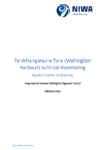Te Whanganui-a-Tara (Wellington Harbour) Subtidal Monitoring – Results from the 2020 Survey
Search in document library
The 2020 sediment survey of Te Whanganui-a-Tara (Wellington) Harbour showed that bottom sediments were very muddy (69-96% mud) at 14 of the 15 subtidal sites sampled. Only southern Evans Bay was found to be mostly sandy. Most heavy metals measured (arsenic, cadmium, chromium, nickel) and total PAHs were below safe guidelines at all sites, while the site near the entrance of the Te Awa Kairangi (Hutt River) as well as the one near Matiu (Somes) Island did not exceed guidelines for any of the chemical contaminants measured. Lead and mercury, two of the most toxic heavy metals, concerningly exceeded guidelines at all other sites. Zinc and copper were also above guideline concentrations in eastern Evans Bay, and in and around Lambton Basin, while sites near Aotea Quay were approaching exceedance concentrations for copper. Should these sediments be disturbed, toxic contaminants may be released from the mud, possibly killing marine life. The benthic communities at each site were generally diverse with reasonable abundances of bivalves, polychaete worms and crustaceans, mixtures of functional types (e.g., suspension feeders, deposit feeders), and an assortment of disturbance tolerant and sensitive species. This shows that a healthy infaunal community is managing to persist despite pollution and sedimentation pressures.
Reference: Cummings V, Halliday J, Olsen G, Hale R, Greenfield B, Hailes S, Hewitt J. NIWA. Te Whanganui-a-Tara (Wellington Harbour) Subtidal Monitoring – Results from the 2020 Survey. NIWA Report WRC20304 prepared for Greater Wellington Regional Council, February 2022. 70p.
